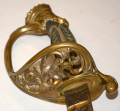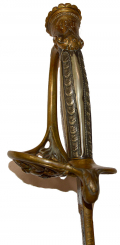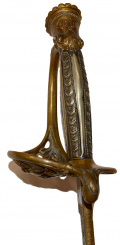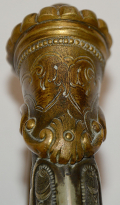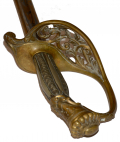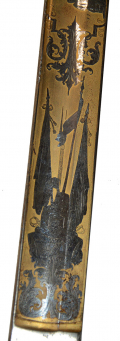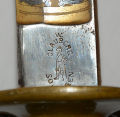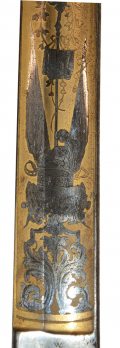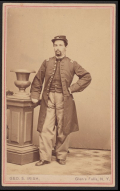site search
online catalog
BEAUTIFUL, ORNATE, SILVERED AND GILT PRESENTATION SWORD OF LT. GEORGE H. WING 14th NEW YORK HEAVY ARTILLERY, SERVED AS INFANTRY 1864: SPOTTSYLVANIA, COLD HARBOR, PETERSBURG ASSAULT, CAPTURED AT THE CRATER

$6,500.00 SOLD
Quantity Available: None
Item Code: 1179-066
Formerly in the collections of the Texas Civil War Museum, this high-grade officer’s sword was presented to Lt. George H. Wing of the 14th NY Heavy Artillery by his company just nine days before they headed to the front. Wing had prior service in the 118th NY and with the 14th saw heavy action serving as infantry, losing 215 officers and men killed or mortally wounded and another 440 who were wounded but survived. During Wing’s time with the regiment they fought at Spotsylvania and the Ny River, around Beulah Church at Cold Harbor, in the first assault on Petersburg on June 17, then in the Petersburg trenches, and in the July 30 Battle of the Crater, where the regiment was part of Ledlie’s Division, leading the botched assault, and where Wing was captured, dying in 1868 of disease attributed to his time in a Confederate prison camp.
The sword is ornate, with elaborately cast and chased gilt brass hilt and silver grip similar to Schuyler, Hartley and Graham No. 19 in their 1864 catalog. The impressive blade is gilt etched with military and patriotic motifs in outstanding condition. The blade has a clear Clauberg mark on the reverse ricasso, but there is no retailer’s address. Schuyler, Hartley and Graham is certainly a possibility: the entire regiment was stationed in New York Harbor from January to April 23, 1864, nine days after the presentation of the sword at Willet’s Point, New York Harbor.
The hilt is deeply cast and chased with a densely decorated, oval pommel cap with bead and leaf decoration, a heavily beaded brim, and pommel with C-scrolls and floral motifs both incised and raised. These are repeated in looser form in the openwork guard as scrolling leafy branches. The silver grip is channeled with long panels having rounded upper ends, beaded interior borders, and filled with rows of overlapping scales that might also be read as crescent moons with small circles on a stippled ground. The hilt retains some light gilt finish, but is largely a mellow aged brass, and the silver grip shows tarnish in the recesses, but lighter on the raised surfaces from handling. The blade pad is in place on the underside of the guard.
The blade is outstanding for condition, with bright etched motifs on gilt ground panels about 13 inches long from the upper edge of the ricasso on either side and along the spine of the blade, which has a winding, leafy vine on gold ground along with “IRON PROOF” near the guard. The obverse starts with back to back floral scrolls over which is a tall stand of arms with drum, swords, bayonetted musket, tall banners and pennant on spearpoint lances, etc. The central panel is framed on either side by matching geometric floral motifs mirroring one another. The panel itself has a central oval cartouche with three soldiers to its left, one seated and two standing, around a field piece, and two soldiers and an officer to the right, all wearing kepis. The central cartouche is a bit anomalous, showing what seems to be a seated female warrior or huntress with helmet and spear, surrounded by what appear to us to be a pack of hunting dogs, with silvered mountains in the background and what we take to be a setting sun, with the word “EUREKA” overhead and possibly Indian teepees in the left background. This would seem to be clear allusion to California, not the most relevant motif for a New York soldier, but perhaps appropriate for the American market in the mind of the etcher. We note a Clauberg blade with a Massachusetts seal surrounded by very similar soldiers shown by Thillmann on page 300. The etching concludes with a foliate script “U S” encircled by floral, leafy scrolls. The gilt panel then ends with an arabesque point.
The reverse starts with addorsed floral scrolls similar to those on the obverse, with a similar, though sparser, stand of arms showing short cannons and drum with helmet atop it at bottom, with crossed swords behind it and a pair of tall banners on lances with a rectangular banner on pole at center. The central motif, framed by the same geometric/floral designs as on the obverse, is an American eagle with outspread wings, a US shield on its chest, clutching lightning bolt arrows and olive branch, over a bank of clouds, surrounded by sunburst rays, and holding an E PLURIBUS UNUM ribband in its beak. The panel is finished off by another tall stand of arms with shield, quiver of arrows and what appears to be the bound rods and ax symbolizing the Republic with a Liberty Cap above, two draping banners and a tall halberd at center. The gilt ends in the same Arabesque design. The blade is smooth bright metal on both sides above the etched panels showing just some thin freckling.
The scabbard and mounts are free of dents or dings, and matching the hilt in color scheme and condition, showing light traces of gilt on toned brass throat, rings and ring mounts, and drag, plain on the reverse, but with cast and chased abstract floral designs on the obverse, mostly pointed leaves, on a stippled ground, with the ring bands showing leaves and berries, and the drag some slightly geometric stems to the abstract floral elements. The scabbard body is silvered, now showing some tarnish like the grip, but with other portions a muted silver from handling. Between the ring mounts the scabbard is engraved in a mix of script, block, and Old English lettering, “Presented to / Lieut. George Henry Wing / by the members of Co. L. / 14th Regt. Artillery N.Y.S.V. / Willet’s Point New York Harbor April 14th 1864.”
Wing was born in Buffalo, NY, 8 September 1839 to Halsey Rogers Wing and Harriet N. Walton. The elder Wing was a lawyer, who gave up the practice of law about 1841 to move east to Queensbury, Warren County, NY, where he made a fortune in the lumber business and other enterprises, as well as holding several civic offices, including a judgeship. The 1860 census picks up the family with the father and Wing’s brothers listed as “sawyers” and Henry as a “boatman,” or so it seems to read, which may mean he was involved in the transportation end of the lumber business, though when he first enlisted in the army was listed as a sawyer as well.
George Wing’s first service was in the 118th New York, along with his brother Edgar, enlisting at age 22 at Queensbury, NY, 8/7/62 for three years mustering into Co. A as private 8/10/62, and being promoted corporal 8/29/62. He was honorably discharged 1/22/64 to accept promotion to 2nd Lieutenant in the 14th NY Artillery. (His brother Edgar enrolled in the same company a day later, made sergeant and then became a 2nd Lieutenant, also in January 1864, but was mortally wounded and captured at Drewry’s Bluff 5/16/64.) During his time with the 118th they took part in the siege of Suffolk, Va, in 1863, fighting at Antioch Church and Bakers Crossroads, Franklin, Va, South Anna Bridge (losing 11 men,) and Gloucester Court House.
The 14th Heavy Artillery had begun organizing in late May 1863 in the Rochester area, but recruited widely, began mustering in by company starting in late August, and was posted at various points in New York Harbor until the organization was complete, leaving for the front in April 1864. Wing enrolled in the regiment on January 9, 1864, but was not mustered in as 2nd Lieutenant of Company L until March 3. His discharge from the 118th only on Jan. 22 may have had something to do with the delay, but the problem seems to have been with the officer first appointed to the post, who was also in line for a 1st Lieutenant’s spot, and with delays in delivery of commissions. In any case, the regiment was ordered to the front on April 23, where they joined the 1st Division, 9th Army Corps, and on May 2 were on the march for the Rapidan in Grant’s Overland Campaign.
The regiment was lightly engaged at the Wilderness, but took heavier casualties at Spotsylvania soon after, with almost daily smaller losses thereafter, punctuated by further heavy casualties at Cold Harbor (15 killed, 43 wounded and 16 missing,) and the June 17 assault on Petersburg (38 killed, 152 wounded, 60 missing; total, 250.) One of the regiment described the latter assault: “Our division was drawn up in line, and the order was passed along to fix bayonets. The 1st Brigade was to lead the charge—our regiment the second line, and the 2d Pennsylvania the third line. The order was not to fire a shot until we took the enemy's breastworks at the point of the bayonet, which we did in a splendid manner. The 1st Brigade fell back, and our regiment charged over them, a distance of two thousand yards, and took the enemy's breastworks at the point of the bayonet. Our regiment behaved splendidly, and went into the fight 930 strong and came out 649 men. We took the rebel pits, a battle flag and 250 prisoners; also a rebel General prisoner. —We held the enemy's breastworks two hours until our ammunition gave out, when the rebels charged in two lines of battle on the breastworks, which we were forced to give up after a desperate hand to hand fight.”
For the next six weeks the regiment was involved with the trench fighting around Petersburg, and then on July 30 was in Ledlie’s Division, selected at the last moment to lead the assault when the mine was exploded under the Confederate works: “At the mine explosion the regiment was selected to lead the assault at the crater and was the first to plant its colors on the enemy's works, where it captured a Confederate flag. Its casualties in this action were 10 killed, 44 wounded and 78 missing; total, 132.” That simple account understates the horrendous fighting, with Union troops essentially trapped in the crater made by their own mine.
Wing was among the captured and was interned at Macon, Ga. The regiment’s muster roll abstracts indicate he was paroled after “7 months and 19 days,” which would put it around February 19, 1865. The regiment was still in field, and had fighting yet to come, at Fort Stedman and elsewhere. We are not told when Wing was officially exchanged, but it does not seem to have been before being given a thirty-day leave on March 11 with directions to return to Camp Parole on its expiration. He must have been surprised to find he had been promoted while a prisoner of war, being commissioned a 1st Lieutenant on Oct. 30, 1864, with rank from October 17, though in fitting bookend to his first appointment, where he was mustered but not did not receive a commission, in this case he was discharged for disability on May 15 before he could be mustered.
Wing may have returned to the family business after getting home. We find that he married in 1866. The disability for which he was discharged in 1865, likely related to his imprisonment, however, seems to have weakened him. He died in Covington, Kentucky, on July 24, 1868, and was interred back in Glens Falls on July 29. When his father died two years later he was credited with giving two sons to his country: “one of whom fell in battle and the other died of disease consequent upon hardships in a rebel prison.” We show a photograph of Wing taken in Glen’s Falls, and note he is wearing 1st Lieutenant straps, indicating the image was taken after his parole as a prisoner of war. Even allowing for the rather baggy clothing fashionable at the time, he is having a hard time filling out his uniform.
This is wonderful sword presented to an officer with an active record and just as much a casualty of the war as his brother. [sr][ph:L]
~~~~~~~~~~~~~~~~~~~~~~~~~~~~~~~~~~~
THIS ITEM, AS WITH ALL OTHER ITEMS AVAILABLE ON OUR WEB SITE,
MAY BE PURCHASED THROUGH OUR LAYAWAY PROGRAM.
CLICK HERE FOR OUR POLICIES AND TERMS.
THANK YOU!
Inquire About BEAUTIFUL, ORNATE, SILVERED AND GILT PRESENTATION SWORD OF LT. GEORGE H. WING 14th NEW YORK HEAVY ARTILLERY, SERVED AS INFANTRY 1864: SPOTTSYLVANIA, COLD HARBOR, PETERSBURG ASSAULT, CAPTURED AT THE CRATER
For inquiries, please email us at [email protected]
Most Popular
Historical Firearms Stolen From The National Civil War Museum In Harrisburg, Pa »
Theft From Gravesite Of Gen. John Reynolds »
Cavalry Carbine Sling Swivel »
Fine Condition Brass Infantry Bugle Insignia »
featured item
VERY SCARCE EARLY CIVIL WAR NEW YORK RECRUITING AND RENDEZVOUS BANNER FOR A COMPANY OF THE “NATIONAL GUARD ZOUAVES” CA. APRIL 1861
This colorful call for volunteers reads “HEAD-QUARTERS – OF – CAPT. GOTT’S / COMPANY / National Guard / ZOUAVES.” The lettering is done in black with red highlights and the last line. “ZOUAVES” is emphatically shadowed in pale green.… (1052-171). Learn More »






